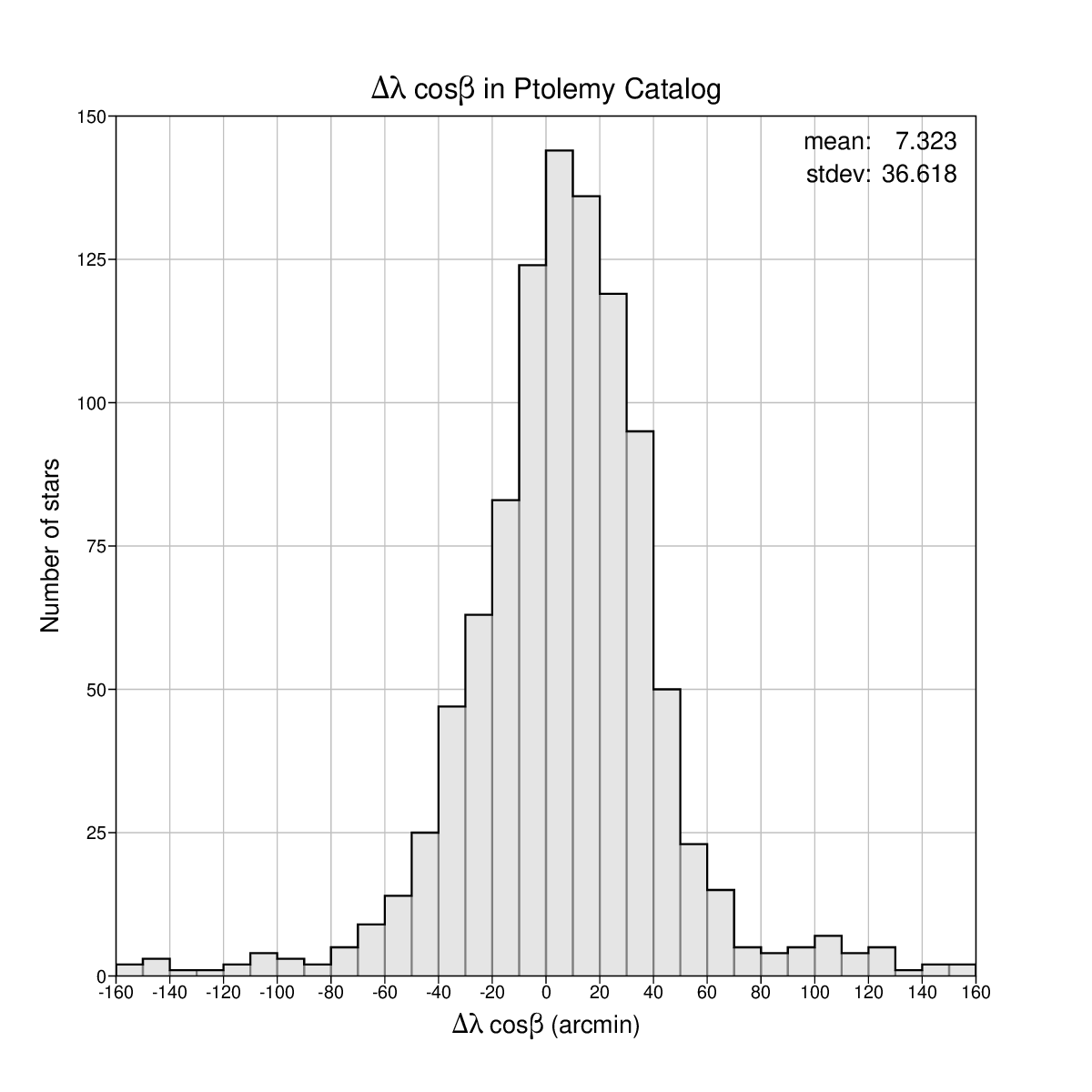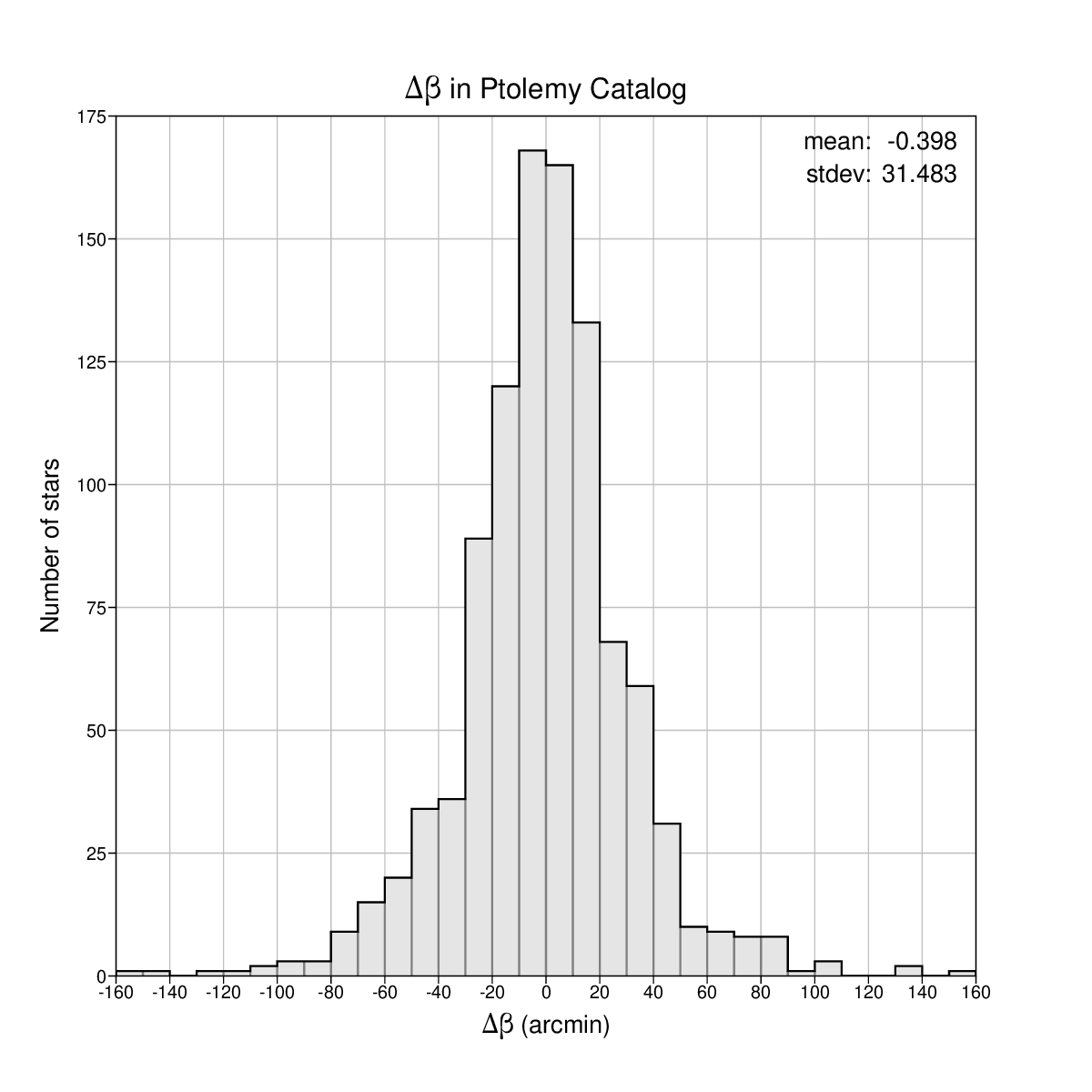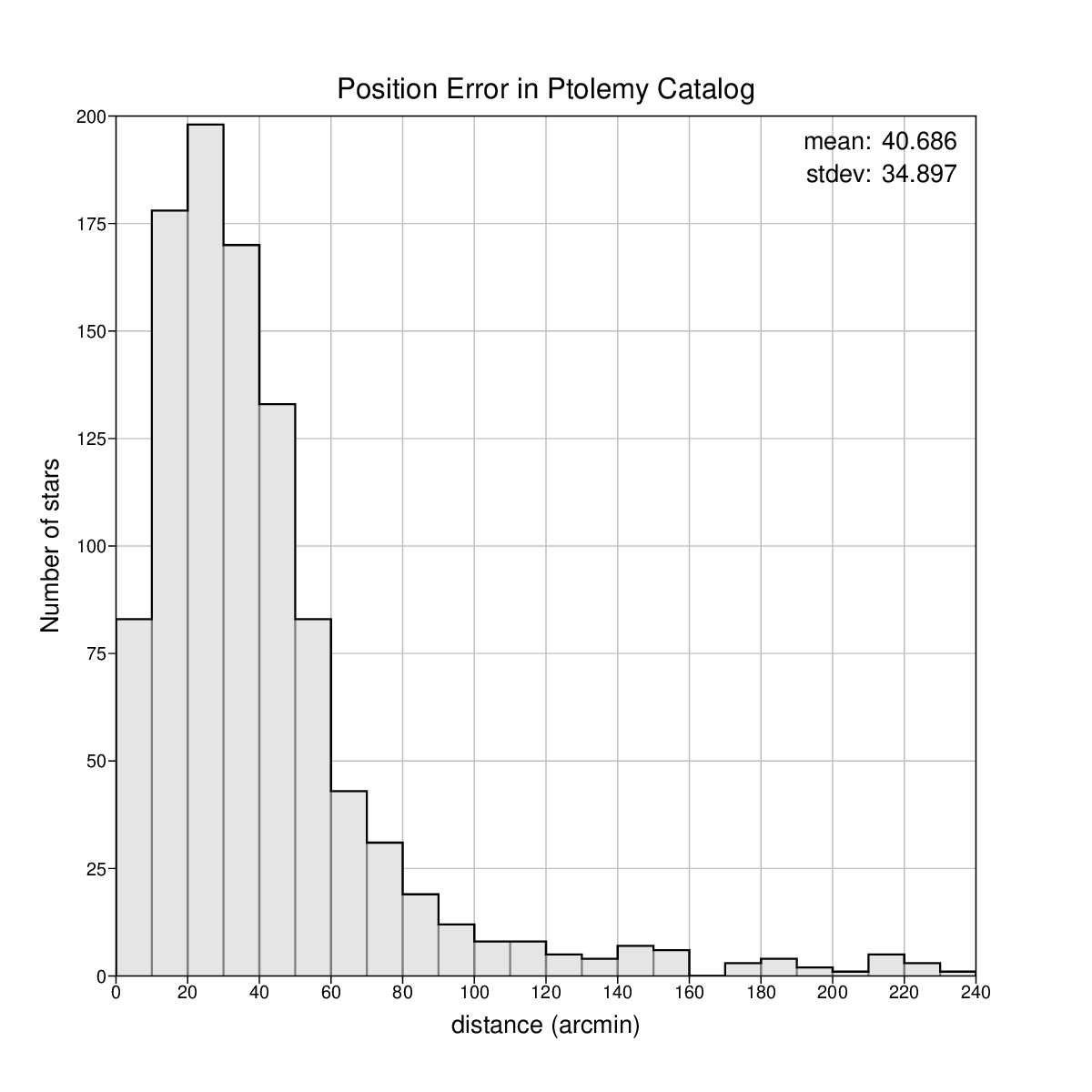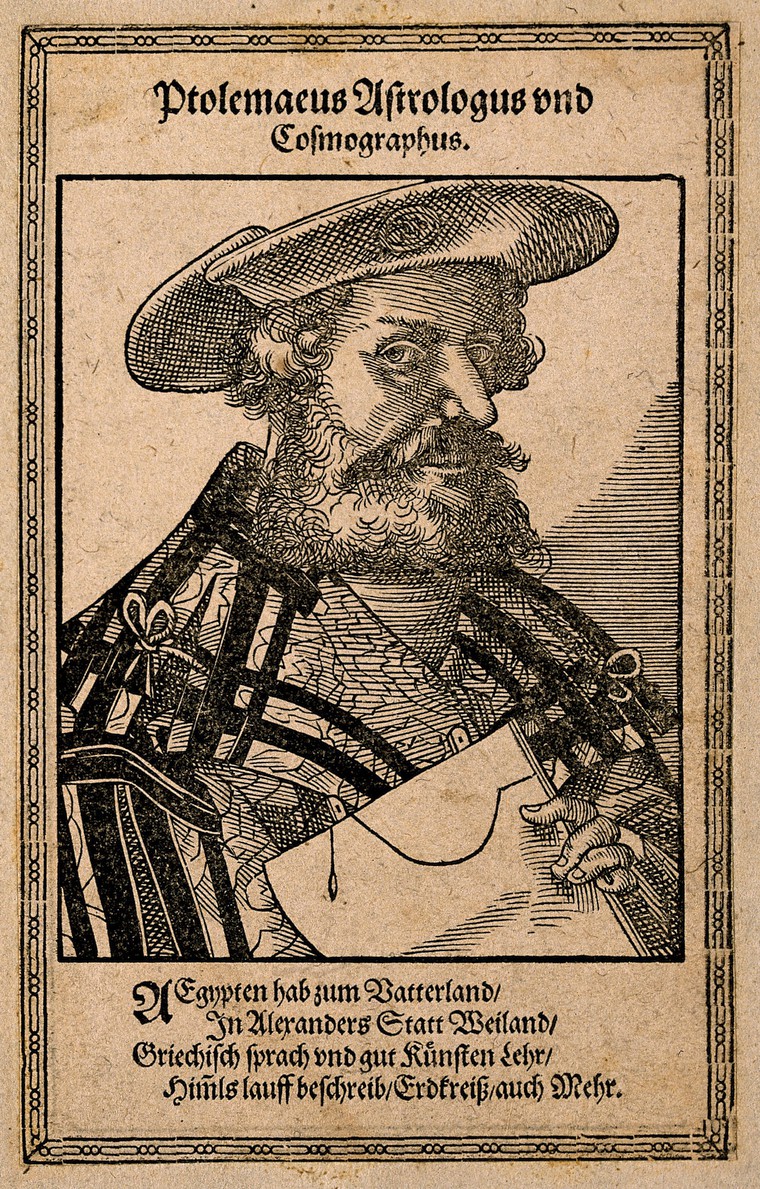Introduction
Claudius Ptolemy (c. AD 100 – c. 170) was a Greco-Roman mathematician and astronomer who lived in Alexandria, in the Roman province of Egypt. He wrote a treatise on astronomy entitled Μαθηματικὴ Σύνταξις (Mathematical Treatise) known as the Almagest after the Arabic version of its name, that remained the reference work on astronomy for about 1500 years. It contains the most ancient star catalog that we possess, thought to be an adaptation and possibly an extension of a more ancient catalog composed by Hipparchus more than two centuries earlier (see Rawlins [3]).
Ptolemy's catalog contains 1028 entries representing 1025 distinct stars or nebulous objects (in three instances, listed below, two entries refer to the same star in the context of different constellations). It provides not only the stars' ecliptic coordinates and magnitudes, but also the descriptions of their positions with respect to the traditional constellation figures drawn in the sky, such as the Big Bear, Andromeda, Capricornus, etc., the so-called 48 Ptolemaic constellations. These descriptions have been more or less adhered to by subsequent celestial cartographers such as Johann Bayer [13], John Flamsteed [10], Johannes Hevelius [12], Johann Elert Bode [9], and Friedrich Argelander [6].
A lot of ink has already been shed over Ptolemy's work by eminent scholars. I don't have anything new to add, but I wanted to make available an electronic copy of the catalog as close as possible to the original, without "corrections" or additions of my own, as I have done in the cases of the constellation boundaries and Flamsteed's catalog. This data has survived for almost 2000 years (even more, if we think that it came from Hipparchus), first in manuscript form, then printed form, then scanned electronic form, and the natural next step seems to be to convert it to an electronic format susceptible of treatment by computer programs.
Unfortunately, as explained in the introduction to Peters & Knobel [4], all the copies and translations of Ptolemy's catalog that have survived are plagued with transcription errors. Several authors have tried to restore a plausible version, with different results. I ended up working with six different versions of the catalog, in scanned or paper form.
- The star catalog from Toomer's translation of the Almagest [2]. I encoded it from the original (taking the corrigenda on pp. xii–xiii into account) and compared the result with its previously digitized version [14], VizieR catalog J/A+A/544/A31, for confirmation. The few differences in star positions that I found are documented in notes_t.dat.
- Peters & Knobel's version [4], because Peters seems to have gone to great lengths to compile as many manuscripts as he could in order to figure out what the original data looked like. For Toomer [2, p. 14], it is "still the best treatment of the catalog as a whole..." although he adds "... though badly in need of updating and revision in certain respects". I copied it from scratch and compared the result with its previously digitized version [17], which allowed me to correct my initial typos and find several others in [17] as well.
- Baily's version [7], since Peters & Knobel refer to it and Baily has critically examined several printed versions of the catalog. Baily also introduces a convenient global numbering of Ptolemy stars, also used by Peters & Knobel, that I have used consistently for all versions.
- Manitius's version [5], referred to by Toomer and Peters & Knobel, and the source of VizieR catalog V/61 [16]. There are just a few differences in coordinates between Manitius and V/61, documented in notes_m.dat, but quite a few in star identifications, of which several look like typos in V/61. John Pratt's version [15], based according to his page on the translation of the Almagest by R. Catesby Taliaferro, is also very close to Manitius's. The few differences in star positions and magnitudes are documented in notes_m.dat as well.
- Halma's version [8], the first and so far only French translation of the Almagest from the Greek. I copied the star descriptions (in French) from this version, but gave up copying the rest of the catalog because the star identifications contain too many typographical errors due to confusions between similar characters.
- Flamsteed's version contained in Historia Coelestis Britannica [11], because I wanted to compare its star identifications with the ones implied in Flamsteed's own catalog, which mentions Ptolemy catalog numbers when possible. It turns out that there are many differences, some of them maybe unintentional, but in many cases as if Flamsteed had changed his mind between the two versions.
Catalog data
Each catalog is split into a stars-*.dat file with the star identifiers, coordinates, and magnitudes, and a descr-*.dat file with the star descriptions. The stars_*.dat files are pure ASCII files; the descr-*.dat files are UTF-8 encoded due to the Greek characters, the accented and other special characters of French and German, and some special characters in Latin (the browser or text editor may need to be configured to use the Unicode or UTF-8 encoding to display these files properly). This allows the stars_*.dat to be validated based on the file description in ReadMe using the Anafile package of the VizieR service, which doesn't allow non-ASCII characters. The notes_*.dat are free-form files with various observations about the originals.
The following files are available.
| File name | Explanation |
|---|---|
| ReadMe | File descriptions |
| stars_t.dat | Ptolemy's catalog from Toomer |
| stars_p.dat | Ptolemy's catalog from Peters & Knobel |
| stars_b.dat | Ptolemy's catalog from Baily |
| stars_m.dat | Ptolemy's catalog from Manitius |
| stars_z.dat | Ptolemy's catalog from Flamsteed |
| descr_p.dat | Descriptions from Peters & Knobel (Latin) |
| descr_b.dat | Descriptions from Baily (Greek) |
| descr_m.dat | Descriptions from Manitius (German) |
| descr_h.dat | Descriptions from Halma (French) |
| descr_z.dat | Descriptions from Flamsteed (Latin) |
| notes_t.dat | Notes on Toomer's version |
| notes_p.dat | Notes on Peters & Knobel's version |
| notes_b.dat | Notes on Baily's version |
| notes_m.dat | Notes on Manitius's version |
| notes_h.dat | Notes on Halma's version |
| notes_z.dat | Notes on Flamsteed's version |
I have double-checked my work very carefully and I hope that no transcription errors are left. If any are found, I would appreciate the feedback.
Duplicate entries
As mentioned earlier, there are three pairs of duplicate entries in Ptolemy's catalog. They are the following.
| Ptolemy identifiers | Modern equivalents | ||||||||||||
|---|---|---|---|---|---|---|---|---|---|---|---|---|---|
| 96 | Boo | 9 | = | 147 | Her | 29 | Boo | ν | = | Her | ψ | ||
| 147 | Her | 29 | = | 96 | Boo | 9 | Her | ψ | = | Boo | ν | ||
| 230 | Aur | 11 | = | 400 | Tau | 21 | 23 | Aur | γ | = | 112 | Tau | β |
| 400 | Tau | 21 | = | 230 | Aur | 11 | 112 | Tau | β | = | 23 | Aur | γ |
| 670 | Aqr | 42 | = | 1011 | PsA | 1 | 79 | Aqr | = | 24 | PsA | α | |
| 1011 | PsA | 1 | = | 670 | Aqr | 42 | 24 | PsA | α | = | 79 | Aqr | |
Nebulous objects
Ptolemy's five nebulous objects are summarized in the following table. Only 191 Per 1 and 449 Cnc 1 correspond to actual non-star objects.
| Ptolemy | Bayer / Fl. | Comment | ||||
|---|---|---|---|---|---|---|
| 191 | Per | 1 | Per | h | Double cluster NGC 869 / 884 | |
| Per | χ | |||||
| 449 | Cnc | 1 | Open cluster Praesepe, M44, NGC 2632 | |||
| 567 | Sco | ~1 | Sco | G | Marked nebulous maybe because of the proximity of NGC 6441 (Peters & Knobel) | |
| 577 | Sgr | 8 | 32 | Sgr | ν1 | There are several small stars close by (Peters & Knobel) |
| 35 | Sgr | ν2 | ||||
| 734 | Ori | 1 | 29 | Ori | λ | Marked nebulous maybe because it forms a small cluster with 37 Ori φ1 and 40 Ori φ2 (Peters & Knobel) |
On the other hand, the entry 855 Cen 21 corresponds to the globular cluster ω Cen (NGC 5139) and 559 Sco 14 most likely to the open cluster NGC 6231 but they are not identified as a nebulous objects in Ptolemy's catalog.
Star identifications
The files ident_*.dat listed below summarize the star identifications according to various versions of the catalog. The file format is described in ReadMe as well and they are subject to automatic validation. They list every Ptolemy star along with redundant designations (Bayer, Flamsteed, HR, HD, HIP or SAO) of [my interpretation of] the star(s) associated with it by the corresponding author(s).
| File name | Explanation |
|---|---|
| ident_t.dat | Star identifications according to Toomer |
| ident_p.dat | Star identifications according to Peters & Knobel |
| ident_b.dat | Star identifications according to Baily |
| ident_m.dat | Star identifications according to Manitius |
| ident_z.dat | Star identifications according to Flamsteed |
| ident_j.dat | Star identifications according to John Pratt [15] |
| ident_a.dat | Star identifications according to VizieR J/A+A/544/A31 [14] |
| ident_f.dat | Star identifications according to Flamsteed's catalog |
| ident_o.dat | Star identifications retained for the maps and the computation of distances |
All the catalog versions associate modern star designations with Ptolemy stars, in the form of Bayer letters, Flamsteed numbers, HR numbers, or less common catalog identifiers (e.g., Piazzi, Groombridge, Hevelius, Heis, Lacaille, Ambronn). Unfortunately, letter assignments have shifted over time due to the contributions of several authors. Most notably, Baily and Flamsteed use the original lettering of Bayer in Argo Navis (Nav), Centaurus (Cen), Lupus (Lup), Ara, and Corona Australis (CrA), while Toomer, Peters, and Manitius use a "post-Lacaille" lettering. Flamsteed also uses some of the letter assignments that he introduced in his own catalog.
Using Morton Wagman's book Lost Stars as primary reference, I have attempted to convert the designations to a consistent, modern form in order to allow a straightforward comparison of the star identifications across catalog versions. I'm not certain of the result in some difficult cases because the history of some letter assignements is complicated and it can be hard to figure out which version an author is using. I have been able to convert most of the less common catalog identifiers to their modern Bright Star (HR), Henry Draper (HD), or Hipparcos (HIP) equivalents by matching the star positions given in their respective catalogs when available online with those of the Hipparcos catalog adjusted for proper motion and precession. A few cases remain where I couldn't figure out which catalog was referred to or for which I don't have access to the catalog data (Ambronn is one of them) at the moment.
I have used the notes interspersed between catalog pages in Baily's version [7] and the notes, pp. 106–113, in Peters & Knobel's book [4] for additional information about star identifications. The table pp. 114–119 of Peters & Knobel compares the uncertain star identifications in several versions of the catalog, including Peters's, Baily's, and Manitius's.
The file ident_o.dat collects the identifications that I have retained for the maps on the next page and the computation of distances in the file dists_to.dat described below. It is subject to change without notice as I examine specific cases more closely or change my mind about some identifications. It should not be considered authoritative. I have followed Toomer's or Peter's identifications in most cases, leaving unidentified some particularly perplexing cases.
Summary files
| File name | Explanation |
|---|---|
| ident_all.dat | Summary of star identifications across all versions |
| pos_all.dat | Summary of star positions across all versions |
| mag_all.dat | Summary of star magnitudes across all versions |
| valid_all.dat | Questionable star identifications across all versions |
| mapping.dat | Bayer to Lacaille mapping in Nav, Cen, Lup, Ara, CrA |
The file ident_all.dat collects the star identifications from all versions in a single file, for easy comparison. It contains the same information as the ident_*.dat files in a different form.
The files pos_all.dat and mag_all.dat respectively summarize the star coordinates and magnitudes of all Ptolemy stars across the versions (except Flamsteed's catalog, which has its own coordinates and magnitudes). They make differences and commonalities between versions immediately apparent.
The file valid_all.dat summarizes the cases where Ptolemy's position differs by more than 2° from the assigned star's. Instances where catalog entries or coordinates are swapped with respect to other versions are also pointed out.
Finally, the file mapping.dat gives a tentative mapping between the obsolete Bayer letters in Nav, Cen, Lup, Ara, and CrA and modern identifiers (Lacaille &c. letters or at least HR numbers). It is based mainly on Baily's associations of Bayer letters with Lacaille catalog numbers (some of which may be controversial) in his identifications of Ptolemy stars. This may be a first step towards a more complete or likely mapping of Bayer's letters in these constellations, which I haven't been able to find anywhere else so far. I used the mapping to resolve the obsolete Bayer letters in Flamsteed's version of Ptolemy's catalog.
Accuracy of the catalog
The file dists_to.dat gives the differences between Ptolemy's positions (according to Toomer's version) and the modern positions of the corresponding stars (according to ident_o.dat) from the Hipparcos catalog (or the SAO catalog if there is no Hipparcos match) adjusted to Ptolemy's epoch and equinox. Its file format is described in ReadMe.
| File name | Explanation |
|---|---|
| dists_to.dat | Differences between Ptolemy's positions and modern ones |
The file gives the differences in ecliptic longitude (multiplied by the cosine of the latitude for normalization), the differences in ecliptic latitude, and the great circle distances, all in minutes of arc. The corresponding histograms below give an idea of the overall accuracy of the catalog (data outside the range of the x axis has been discarded).
| Longitude | Latitude | Distance |
|---|---|---|
 |
 |
 |
The article by Verbunt & van Gent [1] includes similar diagrams and a detailed statistical discussion. I just want to note the position of the peak of the distance histogram, at about 30 arcminutes, and use it as a rough but objective measure of the catalog's general accuracy.
If two independent variables X (the normalized difference in longitude) and Y (the difference in latitude) have normal distributions with mean 0 and the same standard deviation σ, then the distribution of the variable Z = √X2+Y2 (the distance, approximately) is the Rayleigh distribution, with probability density g(x) = x / σ2 exp(-x2/(2σ2)) for x ≥ 0. This function has a maximum at x = σ.
The assumptions about X and Y seem to hold fairly well in this case, so that σ is also the approximate position of the peak.
References
[1] The star catalogues of Ptolemaios and Ulugh Beg by F. Verbunt and R. H. van Gent, Astronomy & Astrophysics, 455, A31 (2012).
[2] Ptolemy's Almagest translated and annotated by G. J. Toomer, with a foreword by Owen Gingerich, Princeton University Press, 1998 (pp. 341–399). Available in print.
[3] Dennis Rawlins, An Investigation of the Ancient Star Catalog, Publications of the Astronomical Society of the Pacific, Vol. 94, p. 359, 1982.
[4] Christian Heinrich Friedrich Peters & Edward Ball Knobel, Ptolemy's Catalogue of Stars - A Revision of the Almagest, The Carnegie Institution of Washington, 1915 (pp. 27–50). Available here and here.
[5] Karl Manitius, Des Claudius Ptolemäus Handbuch der Astronomie, B.G. Teubner, Leipzig, 1912-13 (Tome 2, pp. 32–63). A German translation of the Almagest available here.
[6] Friedrich Argelander, Uranometria nova, Berlin: Schropp, 1843.
[7] Francis Baily, The Catalogues of Ptolemy, Ulugh Beigh, Tycho Brahe, Halley, Hevelius, Deduced from the Best Authorities. With Various Notes and Corrections, and a Preface to Each Catalogue. To Which is Added the Synonym of each Star, in the Catalogues of Flamsteed of Lacaille, as far as the same can be ascertained. Memoirs of the Royal Astronomical Society, Vol. 13, London, 1843. Available here and here.
[8] Nicholas Halma, Composition mathématique de Claude Ptolémée, traduite pour la première fois du grec en français, sur les manuscrits originaux de la bibliothèque impériale de Paris. H. Grand, Paris, 1816 (Tome 2, pp. 33–83). A Greek version and French translation of the Almagest available here.
[9] Johann Elert Bode, Uranographia sive Astrorum Descriptio, Berlin, 1801. Plates available on Felice Stoppa's Atlas Coelestis site.
[10] John Flamsteed, Atlas Coelestis, London, 1729. High resolution plates visible here.
[11] John Flamsteed, Historia Coelestis Britannica, London, 1725. Available here.
[12] Johannes Hevelius, Firmamentum Sobiescanum, in Prodromus Astronomiae, Gdańsk: Johann Zacharias Stoll, 1690. High resolution plates visible here.
[13] Johann Bayer, Uranometria, Augsburg: Christoph Mang, 1603. High resolution plates from a 1655 edition are available here.
Online versions of the catalog
[14] VizieR catalog J/A+A/544/A31 by F. Verbunt and R. H. van Gent (2012), an electronic version of Ptolemy's catalog based on the translation by G. J. Toomer.
[15] John P. Pratt's page on Ptolemy's Star Catalog, and his electronic version of the catalog (2015).
[16] VizieR catalog V/61 (1987), an electronic version of Ptolemy's catalog based on the translation by K. Manitius, according to the ReadMe file.
[17] An electronic version (in HTML) of Ptolemy's catalogue on Brian Tung's site, also mentioned here. This is a transcription of Peters & Knobel's version, with additional data fields. It also appears on the Atlas Coelestis site of Felice Stoppa.



